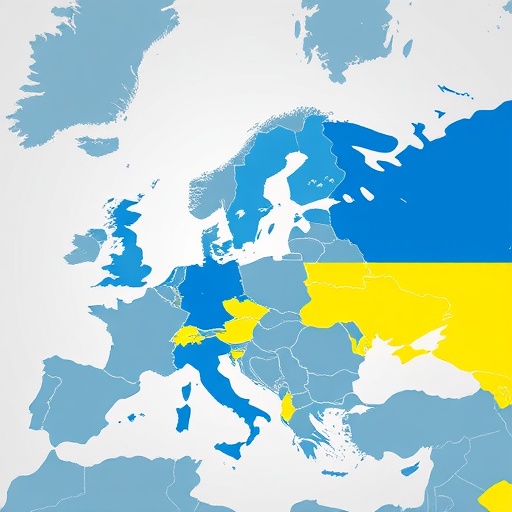Allied Nations Vow to Eradicate Russian oil and Gas from Global Markets in Bold Ukraine Support Move
In a seismic shift for international energy dynamics, leaders from the UK, US, and a coalition of allied nations convened in London on Wednesday to unveil a groundbreaking strategy aimed at completely removing Russian oil and gas from the global market. This pledge, forged in the shadow of Russia’s ongoing invasion of Ukraine, represents the most aggressive escalation of sanctions yet, designed to choke Moscow’s war machine by targeting its primary revenue streams. As energy prices fluctuate worldwide, this united front signals a turning point in the geopolitical standoff, with profound implications for economies far beyond Europe’s borders.
- London Summit Forges Ironclad Energy Isolation Plan for Russia
- Dissecting the New Sanctions Arsenal Against Russian Oil Exports
- Global Market Turbulence: How Booting Russian Oil Reshapes Energy Prices
- Stakeholder Reactions: From Kremlin Fury to Allied Resolve
- Horizon Ahead: Enforcement Hurdles and the Quest for Energy Autonomy
The announcement came after two days of intense negotiations at the historic Lancaster House, where representatives from over 40 allied nations—including key players like Canada, Germany, Japan, and Australia—hammered out details of a multifaceted plan. British Prime Minister Rishi Sunak, hosting the summit, declared, “We are not just imposing sanctions; we are systematically dismantling Russia’s ability to fund aggression against Ukraine. The era of Russian energy dominance ends today.” US Secretary of State Antony Blinken echoed this sentiment, emphasizing that the move would “starve the Kremlin’s coffers while accelerating our transition to cleaner, more secure energy sources.”
This development builds on a series of prior sanctions imposed since Russia’s full-scale invasion of Ukraine in February 2022, which have already slashed Moscow’s fossil fuel exports by nearly 40%. However, with Russian oil still flowing to markets in India, China, and parts of Europe via shadowy rerouting tactics, allied leaders deemed previous measures insufficient. The new strategy focuses on enforcement mechanisms, alternative supply chains, and incentives for global buyers to shun Russian commodities entirely.
London Summit Forges Ironclad Energy Isolation Plan for Russia
The London Summit, dubbed the “Energy Fortress Alliance Meeting,” brought together not just political heavyweights but also energy ministers and economists to dissect the vulnerabilities in Russia’s export infrastructure. Discussions zeroed in on the fact that oil and gas account for over 60% of Russia’s federal budget, funding everything from military operations in Ukraine to domestic propaganda efforts. According to a recent report by the International Energy Agency (IEA), Russia exported approximately 7.5 million barrels of oil per day in 2023, down from pre-war peaks but still a lifeline for the Putin regime.
Key outcomes included a commitment to cap Russian oil purchases at zero by the end of 2025, with interim targets for 2024. The allied nations agreed to pool resources for a “Global Buyer’s Pledge,” where signatories vow to source energy exclusively from non-Russian suppliers. This includes ramping up liquefied natural gas (LNG) imports from the US and Qatar, as well as accelerating renewable projects in Europe. “We’re turning the taps off on Russian gas pipelines and tankers,” said European Commission President Ursula von der Leyen during the closing press conference. “This isn’t punishment; it’s self-preservation for a free world.”
To ensure compliance, the pact introduces enhanced monitoring via satellite tracking of oil tankers and blockchain-based certification for energy provenance. Non-compliant nations face secondary sanctions, potentially barring them from Western financial systems. Historical context underscores the urgency: Since the war began, Russia has evaded sanctions by selling discounted oil to neutral buyers, generating an estimated $300 billion in revenue last year alone, per US Treasury data.
Dissecting the New Sanctions Arsenal Against Russian Oil Exports
At the heart of the London agreement lies a sophisticated web of sanctions tailored to disrupt Russian oil logistics. The plan expands on the existing G7 price cap of $60 per barrel, which has been criticized for loopholes allowing sales above that threshold through third-party intermediaries. New measures include blacklisting additional “shadow fleet” vessels—over 600 tankers suspected of carrying Russian crude—and imposing fines on insurers and shippers who facilitate such trades.
For natural gas, the strategy targets Russia’s remaining European pipelines, like the TurkStream route, by incentivizing Turkey and Serbia to diversify suppliers with subsidies from a $50 billion allied fund. In Ukraine, this is seen as a direct boon: Kyiv has long advocated for total embargoes, arguing that every barrel of Russian oil sold prolongs the conflict. Ukrainian President Volodymyr Zelenskyy, addressing the summit virtually, stated, “These sanctions are weapons in our defense. By cutting Russia’s energy lifeline, you empower Ukraine to reclaim our sovereignty.”
Statistics paint a stark picture of potential impact. The IEA projects that full implementation could reduce Russian energy revenues by an additional 50%, equating to $180 billion annually. This would force Moscow to dip into its $600 billion sovereign wealth fund, reserves that have already dwindled by 20% since 2022. Economists like those at the Peterson Institute for International Economics warn that while short-term disruptions may spike global prices, long-term diversification will stabilize markets.
- Key Sanction Components: Vessel blacklisting, financial penalties for enablers, and trade certification mandates.
- Targeted Revenue Hit: Aimed at slashing 40-50% of Russia’s $400 billion export earnings from oil and gas.
- Enforcement Timeline: Phased rollout starting Q1 2024, with full effect by 2026.
Challenges abound, however. Russia’s pivot to Asian markets—exporting 90% of its oil to India and China in recent months—complicates enforcement. Allied diplomats are engaging Beijing and New Delhi through bilateral talks, offering technology transfers and investment deals in exchange for compliance.
Global Market Turbulence: How Booting Russian Oil Reshapes Energy Prices
The ripple effects of expelling Russian oil from the global market are already evident, with Brent crude prices jumping 5% to $85 per barrel in after-hours trading following the announcement. Analysts predict volatility through 2024, as Europe scrambles to replace 40 billion cubic meters of lost Russian gas annually. Yet, this upheaval carries silver linings: US LNG exports hit record highs last year, reaching 91 million tons, and the EU’s solar installations surged 25% in 2023, per SolarPower Europe data.
For Ukraine, the economic pressure on Russia translates to tangible support. Western aid has topped $150 billion since the invasion, but severing energy ties could hasten a Russian retreat by inflating Moscow’s defense costs. A World Bank study estimates that sustained sanctions have already cost Russia 2-3% of GDP growth yearly, exacerbating inflation at 7.5% and ruble depreciation.
Consumer impacts vary globally. In the US, gasoline prices may rise 10-15 cents per gallon short-term, but federal reserves and increased domestic production mitigate shocks. Developing nations, however, face steeper hurdles; countries like Pakistan and Bangladesh, reliant on cheap Russian fuel, could see energy costs soar 20-30%, prompting calls for allied humanitarian buffers.
Environmental advocates hail the move as a catalyst for green transition. “By sidelining Russian fossil fuels, we’re not just aiding Ukraine; we’re fast-tracking the end of oil dependency,” said Greenpeace International Executive Director Jennifer Morgan. The pact aligns with COP28 pledges, potentially boosting investments in hydrogen and offshore wind by $100 billion over the next decade.
Stakeholder Reactions: From Kremlin Fury to Allied Resolve
Moscow’s response was swift and scathing. Russian Foreign Minister Sergey Lavrov labeled the London pledge “economic terrorism,” vowing retaliatory measures like restricting fertilizer exports, which could disrupt global food supplies amid the Ukraine-induced grain crisis. President Vladimir Putin, in a televised address, claimed the sanctions would “backfire on the West,” citing Europe’s harsh winter energy rationing last year.
Conversely, allied nations project unity. French President Emmanuel Macron tweeted, “Solidarity with Ukraine means ending complicity in Russia’s war economy.” Market experts are cautiously optimistic: Goldman Sachs forecasts that while oil prices may peak at $100 per barrel in Q2 2024, diversified supplies from Norway, Brazil, and the Middle East will cap long-term increases.
In Ukraine, reactions are jubilant yet pragmatic. Foreign Minister Dmytro Kuleba noted in an interview, “This is a game-changer, but we need swift implementation to counter Russia’s adaptive tactics.” Business leaders in energy hubs like Houston and Rotterdam report surging orders for non-Russian commodities, signaling market adaptation underway.
Critics, including some in the Global South, argue the plan exacerbates inequality. Indian External Affairs Minister S. Jaishankar urged “balanced approaches” during side talks, highlighting how Western sanctions inadvertently boost Russia’s Asian pivot.
Horizon Ahead: Enforcement Hurdles and the Quest for Energy Autonomy
Looking forward, the success of this anti-Russian energy crusade hinges on rigorous enforcement and international buy-in. The allied nations plan quarterly reviews starting in March 2024, with a dedicated task force under UN auspices to track compliance. Technological innovations, such as AI-driven trade analytics, will play a pivotal role in closing evasion gaps.
For Ukraine, the timeline is critical: As winter battles intensify, diminished Russian revenues could strain troop morale and logistics. Broader implications include a reconfigured global market, where OPEC+ dynamics shift and renewables gain market share. The IEA anticipates that by 2030, non-Russian sources could cover 95% of allied energy needs, fostering resilience against future aggressions.
Challenges persist—legal battles over extraterritorial sanctions, potential cyber retaliation from Russia, and the risk of black market proliferation. Yet, the London pact embodies a strategic pivot: From reactive measures to proactive isolation of Moscow’s economic arteries. As one US official put it off-record, “We’re not just sanctioning; we’re reimagining a world without Russian oil’s shadow.” This bold vision, if realized, could redefine global security and sustainability for generations.
In the coming months, watch for bilateral deals accelerating LNG flows and investment in Ukrainian reconstruction tied to green energy. The war in Ukraine rages on, but today’s pledge marks a decisive blow to its financier, paving the way for a more equitable energy future.









